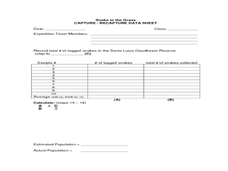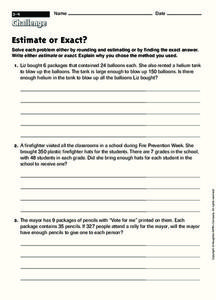Curated OER
Measuring Up
Students examine and discuss a variety of ways to measure length, capacity, and weight. They estimate and measure a pencil's length using Unifix cubes, estimate and fill a measuring cup with Unifix cubes, and weigh a calculator in a...
PBS
Button, Button
Youngsters count, classify, and estimate quantities using buttons after a read aloud of The Button Box by Margarette S. Reid. They discuss the difference between guessing and estimating. Based on an experiment, they predict the number of...
Curated OER
It Takes Ten
Review and use standard units of measure with your math class. They move from station to station estimating and measuring length, volume, weight, and area. At each station they estimate and measure, and then compute the difference...
Curated OER
How Far Can You Jump?
Students estimate the distance of student's broad jumps. This activity can take place in the block center with a small group of students. They are explained that they are going to jump from a starting point (marked with the masking...
Curated OER
The Search for Centimeters
Investigate the length of various objects in metrics! In this measurement lesson, 2nd graders estimate and find the length of objects in the classroom using centimeters.
Curated OER
Nonstandard Units, Practice 17.1
I like this measuring with nonstandard units worksheet! Learners use paper clips and connecting cubes to estimate and measure real objects, and solve 17 problems.
Curated OER
Snake in the Grass: Capture/Recapture Activity
Learners estimate the total number of species in Ecuador using the capture/recapture method. They collect data about each species and act as members of a science expedition to determine the total number of species by using mathematical...
Curated OER
Estimating Sums of Money
By rounding, scholars find that adding money amounts becomes a breeze! They round two and three-digit numbers (with decimals) in these addition problems to get approximate sums. For each, mathematicians write the new addition equation...
Curated OER
Length
In this estimating lengths learning exercise, students observe problems with pictures and lengths and choose the length that gives the best estimate. Students solve 9 problems.
Curated OER
How Does Water Cool?
How fast does water cool? First fifth graders will draw a line on a graph that predicts how fast they think water can cool from boiling. Then they plot the actual data on the same graph to see if their estimate was correct.
Curated OER
Estimate and Check
In this estimation worksheet, students estimate numbers of items shown in pictures, then circle given groups of items, count and write totals.
Curated OER
Estimate High and Low: Compatible Numbers
In this estimation worksheet, students read about compatible numbers and complete a chart, estimating quotients and determining if estimations were "over or under." Students then answer questions related to the chart.
Curated OER
Estimate Using Tens
In this estimate using tens worksheet, 2nd graders match three sets of toys with 3 jars by estimating using tens and reading the label on the jar.
Curated OER
Estimate or Exact?
In this estimate or exact instructional activity, learners complete word problems where they either estimate or find the exact number. Students complete 3 word problems.
Curated OER
Round and Estimate
For this estimation and rounding worksheet, students estimate sums or differences by rounding to the nearest hundred mile, then find the total distance from one given spot to another.
Curated OER
Estimate and Measure Length
For this length worksheet, students estimate how many cubes long items are, then measure, record and compare actual lengths. Houghton Mifflin text is referenced.
Curated OER
Estimate Sums
In this estimating sums worksheet, students solve 6 word problems where they estimate the sum of 3 digit numbers by rounding to the nearest 10, 100 or 1000.
Curated OER
Estimate Division
In this estimate division instructional activity, learners estimate by rounding each number in a division problem to the nearest ten. Answers are included on page 2.
Curated OER
Estimate the Number of Cherries
In this estimating worksheet, students observe groups of five cherries and estimate the total amount. Students choose one multiple choice answer.
Curated OER
Estimate Amount
In this estimating the total amount worksheet, learners observe a page of apples in groups of two and estimate whether there are twenty-five or eighty apples. Students choose one multiple choice answer.
Curated OER
Find The Best Estimate
In this math worksheet, students find the best estimate by using the skill of rounding. The answers are written in the spaces at the bottom of the page.
Curated OER
Problem Solving: Estimate or Exact?
In this number sense instructional activity, 5th graders solve 6 word problems and explain why the answer makes sense. They use either estimated numbers or exact numbers as they solve the problems.
Curated OER
Estimate the Sum
In this estimating worksheet, students round numbers to the nearest ten and estimate sums in a total of 9 problems. Answers are included on page 2.
Curated OER
Estimate Differences
In this estimating differences instructional activity, students estimate differences by rounding to the nearest hundred. Answers are included on page 2.
Other popular searches
- Estimate Fractions
- Compatible Numbers to Estimate
- Estimate Angle Measurement
- Estimate and Measure Length
- Estimate Quotient
- Estimate the Sum
- Estimate Percent
- Estimate Measure Weight
- Estimate by Rounding
- Magnitude Estimates
- Estimate Numbers
- Estimate Fractions For

























